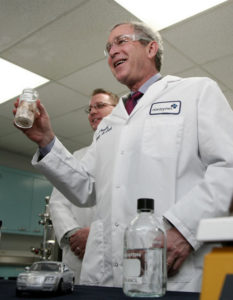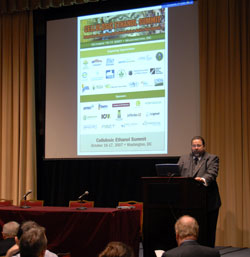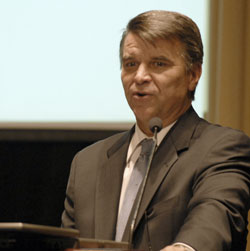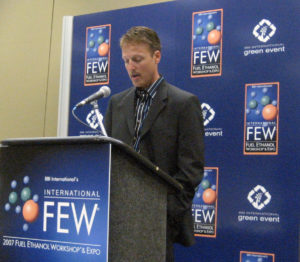All In For Cellulosic
Momentum in early 2007 was strong for increasing the Renewable Fuel Standard and President George W. Bush remained focused on finding other sources for biofuel production, such as the switchgrass he had been touting as an alternative for the past year.

President Bush holds a jar of wood chips during tour of Novozymes North America Feb. 22, 2007 (White House photo)
“We make enzymes. And enzymes is sort of like the key component you need to have when you convert starch or the corn to sugar that you can then make to alcohol or the ethanol,” said Nagy. “But also, it’s got to be the key component when you want to make your switchgrass or your biomass to sugar and then to ethanol.”
President Bush noted the growing concern of livestock producers about the price of corn.
“The problem is we got a lot of hog growers around the United States and a lot of them here in North Carolina who are beginning to feel the pinch as a result of high corn prices,” he said. “A lot of the cattle people around the United States — I have got a few of them in my home state of Texas — they’re worried about high corn prices affecting their making a livelihood. In other words, the demand for corn, because of agricultural use, and now energy use, is causing corn prices to go up.”
The answer to that problem, he said, was to “develop new technologies that will enable you to make ethanol from wood chips, or stalk grass, or agricultural waste.”
Farm Bill Proposals Stress Cellulosic
 Few people even knew the word cellulosic when the 2002 farm bill was written, but it was all over the 2007 farm bill proposals released by the Bush Adminstration U.S. Department of Agriculture under Secretary of Agriculture Mike Johanns.
Few people even knew the word cellulosic when the 2002 farm bill was written, but it was all over the 2007 farm bill proposals released by the Bush Adminstration U.S. Department of Agriculture under Secretary of Agriculture Mike Johanns.
The proposals included $1.6 billion in new funding for renewable energy research, development and production, targeted for cellulosic ethanol, with $2.1 billion in guaranteed loans for cellulosic projects and $500 million for a bio-energy and bio-based product research initiative. In addition, the conservation title proposal included incentives for production of biomass on land in the Conservation Reserve Program, prioritizing “those lands that would be used for growing cellulosic crops like perennial grasses that continue to provide a soil benefit and a wildlife benefit.”
Secretary Johanns also included cellulosic under part of the forestry title. “We’re proposing to initiate a new $150 million wood-to-energy program as part of the president’s mission to expand the use of renewable and alternative fuels,” said Johanns. “To accelerate development of new technologies to use low-value woody biomass to produce energy. We have an abundance of this around the country.”
Johanns said the emphasis on moving toward cellulosic ethanol would help address the concerns that have been raised about increased demand for corn. “I think the livestock industry was very concerned that what we would be proposing is promoting more corn-based ethanol. Our proposals are targeted at cellulosic ethanol. We believe this is the next step.”
Alternative feedstocks for renewable fuels was the key to getting RFS2 and cellulosic ethanol seemed to be the quickest route to using something other than corn.
Cellulosic Search Fuels Investment
Chasing the dream of that perfect feedstock for cellulosic ethanol generated a lot of investment in 2007.
By the end of February, the U.S. Department of Energy (DOE) had announced up to $383 million in grants to support six biorefineries projects using wheat straw, wood chips, grass clippings, and even orange peels. The projects were meant to help achieve President Bush’s goal of using 35 billion gallons a year of ethanol and other alternative fuels by 2017. Combined with the industry cost share, more than $1.2 billion was to be invested in these six biorefineries.
The six projects were:
Abengoa Bioenergy Biomass of Kansas, LLC of Chesterfield, Missouri, up to $76 million for a proposed plant in Kansas to use 700 tons per day of corn stover, wheat straw, milo stubble, switchgrass, and other feedstocks.
ALICO, Inc. of LaBelle, Florida, up to $33 million for a proposed plant to 770 tons per day of yard, wood, and vegetative wastes and eventually energycane.
BlueFire Ethanol, Inc. of Irvine, California, up to $40 million for a proposed plant in Southern California to use 700 tons per day of sorted green waste and wood waste from landfills.
Broin Companies of Sioux Falls, South Dakota, up to $80 million for a plant in Iowa to use 700 tons per day of agricultural residues including wheat straw, barley straw, corn stover, switchgrass, and rice straw as feedstocks.
Iogen Biorefinery Partners, LLC, of Arlington, Virginia, up to $80 million for a proposed plant in Shelley, Idaho, near Idaho Falls tol use 700 tons per day of agricultural residues including wheat straw, barley straw, corn stover, switchgrass, and rice straw as feedstocks.
Range Fuels (formerly Kergy Inc.) of Broomfield, Colorado, up to $76 million for a proposed plant in Soperton (Treutlen County), Georgia to use 1,200 tons per day of wood residues and wood based energy crops.
Abengoa Takes Early Lead
Abengoa had already been on track to develop a biomass pilot plant in York, Nebraska and chose Hugoton, Kansas as the site for the first commercial biomass ethanol plant in the United States. The facility was planned to produce approximately 13 million gallons of ethanol annually from a daily input of 930 tons of cellulosic crop residue such as switch grass, corn stover, grain sorghum and wheat straw from mainly a 50-mile radius of Hugoton. In addition, the facility would also produce 88 million gallons of ethanol using traditional grain processing.
Recognizing the importance of cellulosic for the future of the ethanol industry, the board of directors for the Renewable Fuels Association (RFA) unanimously elected Abengoa Bioenergy executive vice president Chris Standlee as chairman in October 2007.
“It is an honor to be elected chairman of the RFA,” said Standlee. “For more than 26 years, the RFA has worked tirelessly to ensure proper policies and markets are in place to develop a robust U.S. ethanol industry and the results speak for themselves. I intend to work equally as hard to follow the precedent set by Ron Miller and keep our industry on an upward path.”
Broin Waxes Poetic
Broin Companies was never the same after it received $80 million from the DOE. One month after the grants were announced, the nation’s largest ethanol producer changed its name to POET. The company founded by the Broin family was 20 years old at the time, and Poet President and CEO Jeff Broin said they wanted a name that would reflect the unique nature of their organization. “We wanted a name that would represent, rather than describe, who we are and what we do,” Broin said. “As a poet takes everyday words and turns them into something valuable and beautiful; we use creativity that comes from common sense to leave things better than we found them.”
As the company proceeded to change the names of all Broin company holdings, POET wasted no time with its project in Emmetsburg, Iowa, which was to be known as Project Liberty. At the 2007 Fuel Ethanol Workshop in St. Louis, POET announced the successful production of cellulosic ethanol from corn cobs.
“Along with corn fiber, cobs will be the primary feedstock we will use to make cellulosic ethanol at our proudction facillity in Iowa,” said POET CEO Jeff Broin. “For a host of reasons, POET is focused on corn fiber and cobs as the first cellulosic feedstock for our production facilities. First, the fiber that comes from our fractionation process will provide 40 percent of our cellulosic feedstock from the corn kernels that we are already processing in our facility. That means that nearly half of our cellulosic feedstock comes with no additional planting, harvest, storage or transportation needs.”
Industry Hosts Cellulosic Summit
 In October 2007, the industry sponsored a Cellulosic Ethanol Summit in Washington D.C. with 20 supporting organizations and partners, from USDA and the Department of Energy, to the American Coalition for Ethanol, National Corn Growers Association (NCGA), National Ethanol Vehicle Coalition, National Sorghum Producers, Biotechnology Industry Organization, Nebraska Ethanol Board, and the Renewable Fuels Association.
In October 2007, the industry sponsored a Cellulosic Ethanol Summit in Washington D.C. with 20 supporting organizations and partners, from USDA and the Department of Energy, to the American Coalition for Ethanol, National Corn Growers Association (NCGA), National Ethanol Vehicle Coalition, National Sorghum Producers, Biotechnology Industry Organization, Nebraska Ethanol Board, and the Renewable Fuels Association.
It was one of the appearances by Acting Secretary of Agriculture Chuck Conner, who had just taken over the reins of the department when Mike Johanns stepped down the month before to run for the U.S. Senate in Nebraska. Conner was the keynote speaker at the summit on what agriculture’s role was to be in building a national cellulosic industry.
 “We’ve got a number of ongoing research projects to promote this industry and to develop the enzymes the plants are going to be need to have a commercially viable cellulosic based ethanol sector,” said Conner. “We have acknowledged that we need to be doing a lot more and it’s for this reason that in our farm bill proposals that we sent to the Congress that we recommended additional funding of over a billion and a half dollars devoted strictly towards the research, development and commercialization of cellulosic-based ethanol.”
“We’ve got a number of ongoing research projects to promote this industry and to develop the enzymes the plants are going to be need to have a commercially viable cellulosic based ethanol sector,” said Conner. “We have acknowledged that we need to be doing a lot more and it’s for this reason that in our farm bill proposals that we sent to the Congress that we recommended additional funding of over a billion and a half dollars devoted strictly towards the research, development and commercialization of cellulosic-based ethanol.”
RFA’s Dinneen emceed the summit and noted that while the development cellulosic ethanol is important for the future of the industry, it’s no better than corn-based ethanol. “I need to remind people that ethanol is ethanol is ethanol. There’s no good or bad ethanol,” said Dinneen. “The common cause is making sure that our nation has an energy policy that allows us to reduce our dependency on imported petroleum, and that absolutely incentivizes the growth in domestic renewable fuels.”
